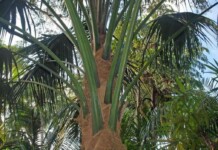
A woman from Trinidad and Tobago has created a startup that’s turning heaps of smelly seaweed and other waste from the island’s rum distilleries into a new, low-emission fuel for cars.
Along with members of her team, she is working on creating the first product under the brand name Rum and Sargassum—a mixture that produces energy when burned, and which they had no idea would work when they started.
The story begins when Dr. Legena Henry began teaching a sustainable energy course at the University of the West Indies Cave Hill campus on the island of Barbados.
“One day in class, while we were discussing transportation, a student raised her hand and said, ‘I am seeing all these electric vehicles around Barbados, but I cannot afford an electric car’,” Henry told the Trinidad Daily Express.
That got Henry thinking—how could Barbados transition 150,000 gasoline cars off gasoline if people can’t afford the alternative? At first, she and a group of students began looking over the summer into one of the great industrializations of Brazil.
Two-thirds of all ICE cars in that country are powered by a renewable fuel derived from sugarcane. However, after three weeks of research, Henry and her students realized that the sugarcane industry on Barbados was shrinking, and couldn’t supply nearly enough feedstock to replicate Brazil’s success.
Instead, Univ. of West Indies student Brittney McKenzie came to a team meeting one day with the suggestion that they look into using sargassum seaweed.
Millions of dollars are spent by Barbados’ beach resorts every year to remove sargassum seaweed that piles up on the beaches, releasing a salty smell similar to rotten fish and driving tourists away.
Tourists are the islands’ largest economic driver, so there was no risk of a drop in production of waste sargassum unless the winds and currents bring it elsewhere in the Caribbean.
While Dr. Henry was doubtful, she didn’t want to dampen her students’ enthusiasm, and with three weeks into summer break, there wasn’t much time left to think of other ideas.
Henry explained that, typically at the start of such a project, she would have her students do a review of the literature to find out if sargassum had ever been used for energy, whether could it generate substantial energy like the kind needed to power a vehicle, or if there were any other inputs needed.
But she deigned there wasn’t enough time left in their project, and advised them to just go ahead and run the experiment.
INSPIRATIONAL EFFORTS LIKE THIS: Compostable Plastic Wrap Made from Seaweed Can Withstand Heat–and Biodegrade in Weeks
“So we did not read the articles. The journals would have told us don’t put sargassum in any biodigester because you are not going to get any energy out of it. But we didn’t read. We didn’t read so we went and did it and guess what? Energy came out of it we got a biogas from sargassum, but it was mixed with rum wastewater,” Henry said.
The rum was the key, and suddenly they had a lead, and began seeking capital from various development agencies and funds to expand their research into a business.
The students involved in the business are now working to study sargassum. Where does it come from and where does it grow, and whether one can map the patterns of its distribution across the Caribbean where it’s a colossal menace to many different countries.
MORE ON SEAWEED: Visionary Gardener Turns Piles of Beached Seaweed Into Bricks for Sustainable Construction
Dr. Henry sees the hypothetical market offering of a simple conversion kit to change ICE cars from burning gasoline into burning Rum and Sargassum fuel products as substantially attractive compared with the cost of a new electric vehicle.
The project could potentially remove 103,000 metric tons of carbon dioxide emissions annually in Barbados, she estimated.
SHARE This Brilliant Woman And Her Brilliant Students’ Brilliant Idea For Barbados…





















I LOVE this story for so many reasons! The power of creativity without the imposed limitations imposed on thinking by “experts” is how all of the great discoveries have come to fruition!